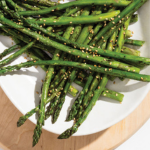What to Know About Green Beans
Green beans, also called string beans, are one of the most popular vegetables in the U.S. They’re a delicious side dish that appears at family get-togethers, holidays, and weeknight dinners. Whether they’re sautéed, steamed, blanched, canned, or frozen, green beans are a delicious and healthy choice.

.png)
.png)

.png)











